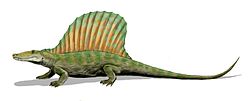| Thrausmosaurus Temporal range: Lower Permian, | |
|---|---|
| Scientific classification | |
| Domain: | Eukaryota |
| Kingdom: | Animalia |
| Phylum: | Chordata |
| Clade: | Synapsida |
| Family: | † Varanopidae |
| Genus: | † Thrausmosaurus Fox, 1962 |
| Type species | |
| †Thrausmosaurus serratidens Fox, 1962 | |
Thrausmosaurus is a genus of synapsid pelycosaurs from the extinct family Varanopidae. Like all that resemble members of Varanopidae, Thrausmosaurus most likely resembled the modern monitor lizard and may have had the same lifestyle. The type and only species was described by R. C. Fox in 1962, from three fossilized jaw fragments bearing teeth. [1] The specimens were recovered from the fissure-fill deposits uncovered in a Limestone Quarry, north of Fort Sill, Comanche County, Oklahoma, USA. These deposits are dated to the Kungurian (Leonardian) of the Lower Permian. [2]





